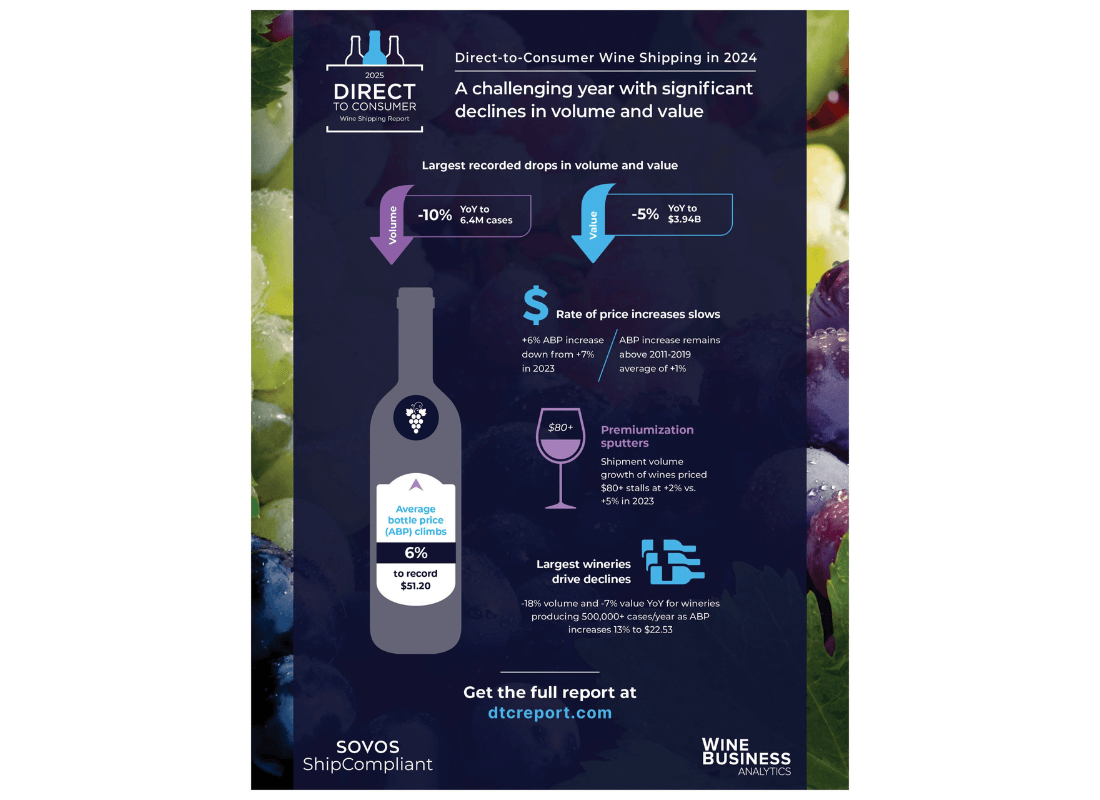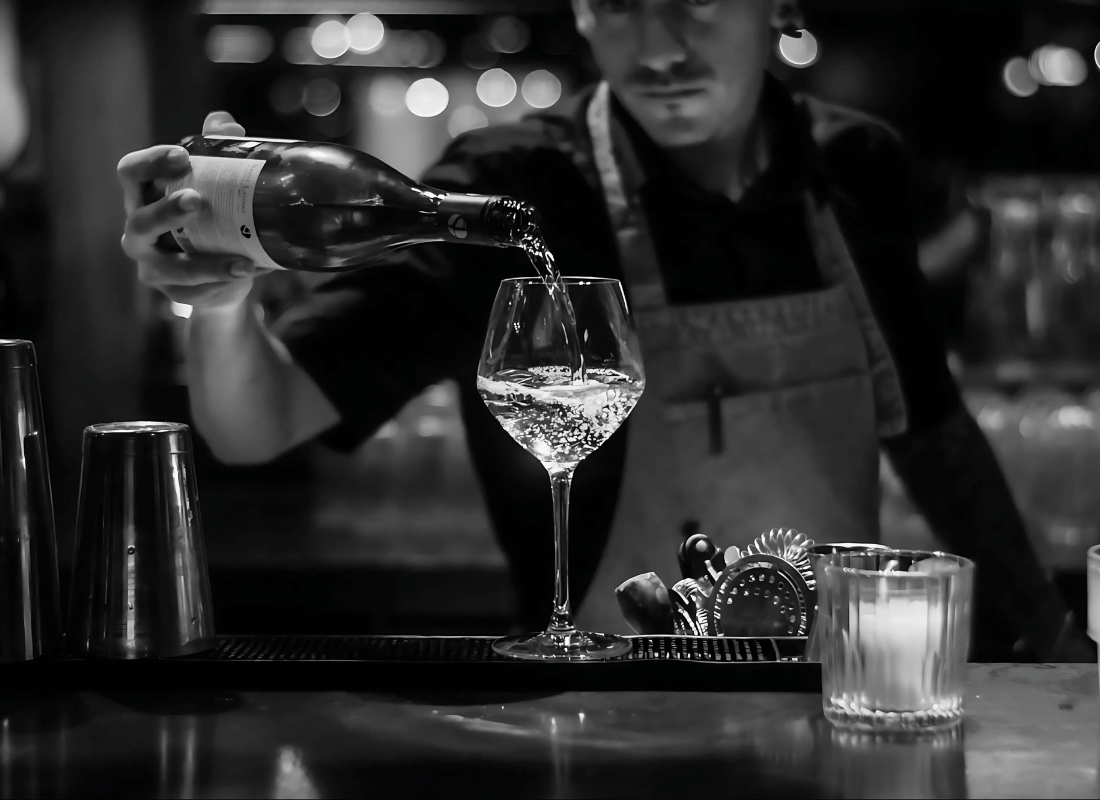Educating Sommeliers Worldwide.
By Beverage Trade Network

In 2024, wineries in Napa and Sonoma counties, known for their world-class wines, faced a sharp decline in direct-to-consumer (DTC) wine sales. According to the latest Sovos ShipCompliant and Wine Business Analytics’ Direct-to-Consumer Wine Shipping Report, the drop in shipments was felt nationwide, with a 10% decrease in volume and a 5% dip in value, marking the steepest recorded decline since the report's inception in 2010. This decline, largely attributed to high inflation and shifting consumer behavior, has sent ripples through the wine industry, particularly impacting how wineries sell their products.
For the on-premise trade—restaurants, bars, and wine retailers—these trends have significant implications. With consumers tightening their belts and a broader economic slowdown, the traditional balance between off-premise retail sales and on-premise consumption is shifting. Understanding these changes and how they intersect with broader wine consumption patterns is crucial for the on-premise wine business.

DTC wine shipments are a vital segment of the wine industry, making up about 8% of U.S. wine sales, which amounted to $51 billion last year. Napa and Sonoma together represent two-thirds of the value and 55% of the volume shipped nationally. However, both regions saw substantial declines in 2024, with Napa experiencing a 12% drop in shipment volume and Sonoma facing a 12% decrease as well. Nationally, the decrease in DTC shipments was especially noticeable in wines priced under $40, which accounted for the largest portion of the total volume. Wines in the higher-end segment over $80 per bottle showed slower growth, with the case sales increasing at a rate of just 2%, compared to 5% in 2023.
The overall decline is attributed to a combination of factors: ongoing inflation, economic uncertainty, and changing consumer preferences. Consumers are more cautious with their spending, particularly when it comes to non-essential luxury items like wine. The slowdown in DTC sales is also part of a broader trend affecting the entire beverage alcohol market, where consumers are increasingly focusing on value and essential purchases rather than splurging on premium products.
For wineries, these declines are a blow to a previously reliable sales channel. Napa’s premium wines—especially its iconic Cabernet Sauvignon—were somewhat shielded by their higher price points. In fact, Napa's average bottle price increased by 6%, reaching a record $91.84, in part due to the focus on high-end offerings. However, even Napa saw a reduction in shipments of red blends and other categories, with some producers struggling to find buyers for more moderately priced wines.
Sonoma, which has been more aggressive in raising prices, particularly in the wake of inflation, also experienced a decline in shipment volume. This price hike strategy has led to a reduction in the volume shipped, as consumers are increasingly reluctant to pay more for wines, even from established brands. The price of Pinot Noir, Sonoma’s flagship varietal, rose 14%, but shipment volume dropped by 10%. While some wines, like Sonoma Sauvignon Blanc, saw slight increases in both price and volume, the overall trend points to a contraction in consumer spending on premium wines.

Source: Unsplash
For the on-premise trade, the decline in DTC shipments signals several important shifts. First, consumers are spending less on wine, particularly in the premium segment. This can create a challenging environment for restaurants and wine bars that rely on selling high-margin bottles. Additionally, the focus on value-driven wines in the off-premise market might lead to a change in consumer expectations when they dine out.
One of the immediate effects could be a heightened demand for lower-priced wines on wine lists. For restaurants, this means a potential recalibration of their wine programs, moving away from the more expensive bottles and focusing more on wines that offer a better value proposition. While consumers may still seek quality, they might become more price-sensitive when dining out, which could mean a shift in the types of wines customers are willing to explore.
At the same time, as DTC sales continue to shrink, wineries may focus more on building relationships with distributors and on-premise buyers. This creates an opportunity for restaurants to negotiate better pricing and secure exclusive allocations of sought-after wines. Smaller wineries, in particular, which are most reliant on DTC sales, may seek to find new routes to market, including strengthening their partnerships with on-premise buyers. For the on-premise trade, this could result in more direct sourcing opportunities, potentially creating new exclusive offerings that are not available through retail or DTC channels.
In response to these shifting dynamics, restaurants and wine bars may need to emphasize the experience of wine consumption as much as the product itself. As consumers become more discerning about their spending, the on-premise experience—ranging from personalized wine pairings to exclusive tasting events—can serve as a key differentiator. Wine lists that tell a story, feature unique or hard-to-find wines, or offer experiential tasting events could provide added value that attracts consumers who are still willing to splurge for a memorable dining experience.
Additionally, the rise of wine clubs and virtual tasting experiences that facilitate direct relationships between consumers and wineries presents an opportunity for the on-premise sector to tap into this growing trend. Restaurants could consider collaborating with local wineries to offer curated tasting menus or private wine events that bring the DTC experience to the table. This approach not only aligns with the broader trend but also helps to drive wine sales while enhancing customer engagement.
[[relatedPurchasesItems-61]]
As the wine industry adapts to changing market conditions, the on-premise trade will need to remain nimble. While DTC sales continue to face pressures, the experience-driven aspect of wine consumption offers opportunities for innovation. Wineries that can navigate this shifting landscape by adapting their pricing strategies and forging stronger connections with the on-premise sector will be well-positioned for future growth. Similarly, restaurants and wine bars that stay attuned to the evolving needs of their consumers, offering personalized and value-driven experiences, will continue to thrive in this challenging environment.
Header Image Source: Riverby Estate
Also Read:
How AI Recommendations are Changing the Norms of Direct-to-Consumer (DTC) Sales
Wineries are creating new channels to drive direct to consumer channels.
Karissa Kruse's Vision: Pioneering Sustainability at Sonoma County Winegrowers